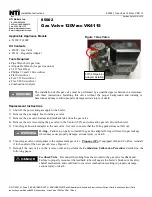
67
MAINTENANCE
2. Before re-starting the
P
URE
F
IRE
®
boiler follow the
steps below:
a. Reconnect the thermostat wires.
b. Open the manual gas shutoff valve and reset the
thermostats.
c. Observe the boiler function to make sure you see
a condensate flow.
d. If you do not observe a condensate flow, repeat
the above procedure.
3. If the problem is not corrected at this point, it is possible
that there is a material deposit problem. Follow the Coil
Cleaning Instructions (Subsection 9E) below to dissolve
deposits and clean the heat exchanger.
E. INSPECTION AND CLEANING OF
COMBUSTION CHAMBER COILS
Before beginning this procedure, you must have on
hand the following items:
–
a nylon or brass brush (not steel)
–
“Rydlyme” (recommended for best results)
(available online www.rydlyme.com) or “CLR”
(available at most hardware stores)
1. Shut the boiler down and access the heat exchanger
using the following steps:
a. Close the manual gas shutoff valve and wait for
the unit to be cool to the touch.
b. Disconnect the condensate piping from the outside
connections (not from the
P
URE
F
IRE
®
side) so the
flow can be observed.
c. Disconnect compression nut on gas valve inlet
and disconnect the gas valve electrical connector.
d. Remove the six 10 mm nuts from the burner
plate assembly. Disconnect wire leads to the
spark igniter and flame sensor. Disconnect two
Molex plugs from blower motor.
e. Pull the entire burner plate towards you to access
the heat exchanger coils.
f.
Significant deposits may be caused by the
recirculation of exhaust gasses, poor fuel quality
or contamination of the air supply. Review
Section 3, Venting & Air Inlet Piping, if deposits
are evident.
2. Using a spray bottle filled with the recommended
product “Rydlyme” or “CLR”, spray liberally on the
coils, making sure the solution penetrates and
funnels down through the condensate hose. If the
condensate hose is blocked, let the chemical
penetrate for at least 15 minutes or until it drains.
3. Use the nylon or brass brush (do not use steel) and
scrub coils to remove any buildup, then vacuum the
debris from the coils.
4. Spray coils with clear water, making sure to confine
the spray to the area being cleaned (try to avoid
wetting the back ceramic wall of the unit). Flush the
combustion chamber with fresh water. At this point,
the
P
URE
F
IRE
®
should be ready to power back up.
5. Reinstall the burner plate assembly using the
following steps:
a. Inspect the inside of the heat exchanger for dirt
and debris.
b. Install the burner plate assembly and replace the
six 10 mm nuts.
c. Reconnect the wire leads to the spark igniter,
flame sensor and gas valve. (Be sure that the
spark igniter is connected to the lead with the
large insulated connection boot.) Reconnect two
Molex plugs on blower motor.
d. Connect the compression nut on the gas valve
inlet and reattach the gas valve electrical
connector.
e. Reset thermostats.
(IMPORTANT: BE SURE
THAT THE VENT CONNECTION IS NOT
BLOCKED.)
f.
Turn the power to the
P
URE
F
IRE
®
on. Observe the
display module to assure proper operation.
g. Initiate a call for heat** and observe the
condensate flow.
h. Reconnect the condensate piping to the drain
connection.
**NOTE: When firing the boiler the first
few times you may experience some
fluttering of the gas burner that may result
in a flame lockout. This is normal and will
require you to recycle the unit until this
clears up. This is caused by water still
present in the combustion chamber.
6. Inspect exhaust vent and air intake vents for proper
support and joint integrity. Repair as necessary. Refer
to Section 5, VENTING.
7. Inspect exhaust vent and air intake vent terminations
for obstructions or corrosion. Corrosion is an
indication of exhaust gas recirculation.
It is extremely important to make sure there is no
blockage in the exhaust vent. Failure to do so may
result in serious personal injury or death.
WARNING
It is extremely important to check for leaks when
reconnecting the gas valve. Failure to do so may
result in severe personal injury, death or major
property damage.
WARNING
Leaks in the vent system will cause products of
combustion to enter structure (vent system operates
under positive pressure).
WARNING
Summary of Contents for PureFire PF-110
Page 77: ...75 REPAIR PARTS Figure 13 3 General Repair Parts PF 200 PF 210 PF 300 PF 399 ...
Page 82: ...80 APPENDIX A STATUS SCREENS APPENDIX A STATUS SCREENS ...
Page 83: ...81 APPENDIX A STATUS SCREENS ...
Page 84: ...82 APPENDIX A STATUS SCREENS ...
Page 85: ...83 APPENDIX A STATUS SCREENS ...
Page 86: ...84 APPENDIX B USER MENU APPENDIX B USER MENU ...
Page 87: ...85 APPENDIX C INSTALLER MENU APPENDIX C INSTALLER MENU ...
Page 88: ...86 APPENDIX C INSTALLER MENU ...
Page 89: ...87 APPENDIX C INSTALLER MENU ...
Page 90: ...88 APPENDIX C INSTALLER MENU ...
Page 91: ...89 APPENDIX C INSTALLER MENU ...
















































